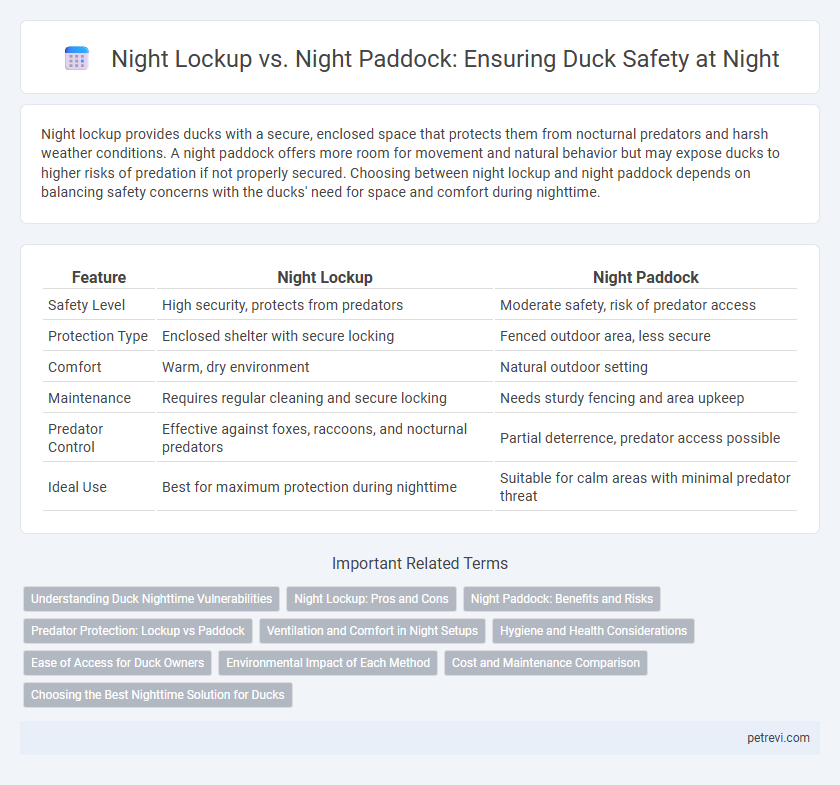Night lockup provides ducks with a secure, enclosed space that protects them from nocturnal predators and harsh weather conditions. A night paddock offers more room for movement and natural behavior but may expose ducks to higher risks of predation if not properly secured. Choosing between night lockup and night paddock depends on balancing safety concerns with the ducks' need for space and comfort during nighttime.
Table of Comparison
| Feature | Night Lockup | Night Paddock |
|---|---|---|
| Safety Level | High security, protects from predators | Moderate safety, risk of predator access |
| Protection Type | Enclosed shelter with secure locking | Fenced outdoor area, less secure |
| Comfort | Warm, dry environment | Natural outdoor setting |
| Maintenance | Requires regular cleaning and secure locking | Needs sturdy fencing and area upkeep |
| Predator Control | Effective against foxes, raccoons, and nocturnal predators | Partial deterrence, predator access possible |
| Ideal Use | Best for maximum protection during nighttime | Suitable for calm areas with minimal predator threat |
Understanding Duck Nighttime Vulnerabilities
Duck nighttime vulnerabilities include susceptibility to predators like foxes, raccoons, and owls, making secure nighttime containment crucial. Night lockups offer enclosed protection with solid barriers, reducing risks of predator attacks and exposure to harsh weather. Night paddocks provide larger space but require reinforced fencing and overhead netting to ensure safety against climbing or flying predators.
Night Lockup: Pros and Cons
Night lockup for ducks offers enhanced protection from predators by securely confining them in a sturdy, enclosed shelter, reducing risks of attacks from foxes, raccoons, and owls. However, the confined space can limit natural behaviors, potentially causing stress or decreased air circulation if ventilation is inadequate. Properly designed night lockups improve safety and health outcomes by balancing security and comfort for ducks during nighttime.
Night Paddock: Benefits and Risks
A night paddock provides ducks with increased space to forage and exercise, promoting natural behaviors and reducing stress compared to confined night lockups. However, risks such as predator attacks and exposure to harsh weather conditions require secure fencing and appropriate shelter to ensure safety. Balancing freedom of movement with protection measures is crucial for duck well-being during nighttime.
Predator Protection: Lockup vs Paddock
Night lockup provides superior predator protection for ducks by securely confining them in a predator-proof enclosure, significantly reducing the risk of attacks from foxes, raccoons, and owls. Night paddocks offer limited safety, as fencing may be insufficient to deter determined predators and allow potential breaches. For optimal nighttime safety, a lockup with sturdy materials and secure latches is essential to prevent predator access.
Ventilation and Comfort in Night Setups
Night paddocks provide superior ventilation for ducks compared to night lockups, allowing fresh air to circulate freely and reducing the risk of respiratory issues. Ducks confined in night lockups often experience limited airflow, which can lead to increased humidity and discomfort. Ensuring proper ventilation in night setups enhances duck comfort, promotes healthier respiratory conditions, and supports overall nighttime safety.
Hygiene and Health Considerations
Night lockups provide a secure, enclosed environment for ducks that reduces exposure to predators and limits contact with wild birds, helping prevent disease transmission and maintaining better hygiene. Night paddocks offer more space for natural behaviors but may increase risks of parasite infestation and exposure to contaminated water or soil, potentially compromising health. Regular cleaning and proper drainage in both setups are essential to reduce the buildup of harmful bacteria and maintain optimal duck health.
Ease of Access for Duck Owners
Night lockups provide secure, enclosed spaces that ensure maximum protection for ducks but may restrict easy access for duck owners during nighttime care. Night paddocks offer greater ease of access with open or semi-enclosed areas, allowing owners to feed, check health, and clean with minimal disturbance. Prioritizing ease of access, night paddocks enable efficient and stress-free nighttime management while maintaining adequate safety for the ducks.
Environmental Impact of Each Method
Night lockup confines ducks in a secure coop, minimizing their exposure to predators and reducing noise pollution, which helps maintain local wildlife balance. Night paddocks allow natural foraging and movement, supporting soil health through natural manure distribution but may increase risk of predation and environmental disturbances. Both methods impact water runoff and habitat interaction differently, with lockups reducing ground compaction while paddocks promote nutrient cycling and biodiversity.
Cost and Maintenance Comparison
Night lockups for ducks involve securely housing them in a coop, which requires an initial investment in building materials and ongoing maintenance such as cleaning and repairs, resulting in moderate costs. Night paddocks offer a more cost-effective solution with lower setup expenses, typically consisting of simple fencing, but may demand more frequent upkeep to ensure predator-proofing and structural integrity. Overall, night lockups tend to have higher upfront and maintenance costs, whereas night paddocks provide a budget-friendly option with increased vigilance needed for protection.
Choosing the Best Nighttime Solution for Ducks
Night lockup offers ducks maximum protection from predators and harsh weather by securely confining them in a predator-proof enclosure, ensuring safety throughout the night. Night paddocks provide ducks with more space to roam and forage while still offering some protection through fencing but may be less effective against determined predators. Choosing the best nighttime solution depends on balancing predation risk, space needs, and environmental conditions to maintain duck health and security.
Night lockup vs Night paddock for Duck nighttime safety Infographic

 petrevi.com
petrevi.com